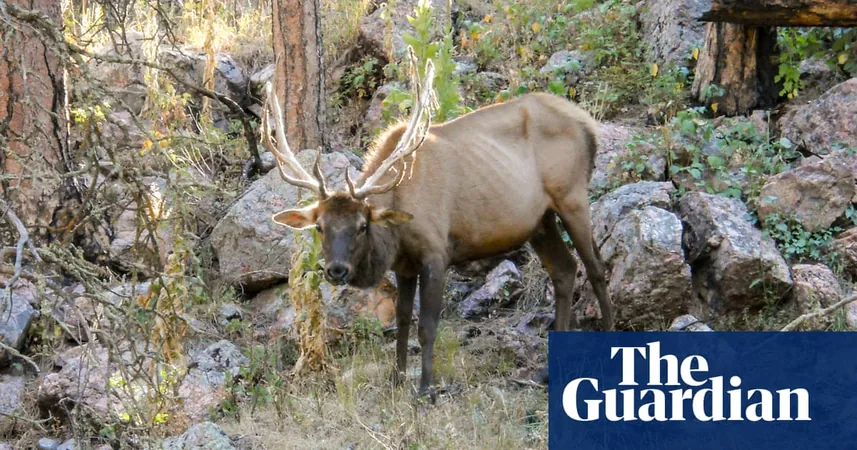
The Alarming Spread of Chronic Wasting Disease: A Looming Crisis for Humanity and Wildlife
2025-03-20
Author: Jessica Wong
Introduction
In a concerning trend, states across the continental U.S. are reporting the emergence of chronic wasting disease (CWD), a catastrophic neurodegenerative disorder affecting deer, elk, moose, and even reindeer in colder regions.
Historical Context and Spread
With roots tracing back to a few isolated cases in Colorado and Wyoming in 1981, CWD has now infiltrated herds in 36 states and is spreading to parts of Canada, as well as reindeer populations in Scandinavia and farmed deer and elk in South Korea.
Public Health Concerns
The disease, often sensationally referred to as 'zombie deer disease' due to its distressing symptoms—such as severe weight loss, drooling, disorientation, and a vacant stare—represents a serious public health and wildlife crisis, according to epidemiologists.
The Implications of Trivialization
This terminology, while catchy, has broader implications, diminishing the gravity of the situation. Michael Osterholm, a prominent infectious disease expert, emphasized that such nicknames trivialize a pressing health risk.
Potential Spillover Effects
He has been actively warning of potential spillover effects to humans through the consumption of infected game meat.
Expert Warnings
A report published in January 2025 by an expert panel highlighted the potential for a CWD spillover to trigger a national and global crisis, warning of far-reaching consequences not only for food safety and human health but also for the economy and agriculture.
Current Status of Human Cases
Although no human cases have been conclusively linked to CWD, the long incubation periods pose significant risks, making vigilant surveillance and diagnostic measures essential.
Cultural Significance of Hunting
Hunting and consuming game meat is ingrained in many American traditions, with a striking 20% of U.S. residents reporting they have hunted deer or elk.
Challenges in Compliance
Alarmingly, many are unaware they may be consuming infected venison; hunters often share their kills among friends and family.
Health Authorities' Recommendations
Health authorities advise testing deer from infected regions, though compliance remains low.
Environmental Contamination
Compounding the CWD crisis is the persistence of prions, the agents that cause the disease. Unlike conventional pathogens, prions are highly resilient, remaining infectious in the environment for years.
Transportation of Deer Carcasses
Recent analyses show that the transportation of deer carcasses across state lines is exacerbating the situation, spreading increasing volumes of prions and raising the specter of widespread environmental contamination.
Concerns from Conservationists
Local inhabitants, like Lloyd Dorsey, an experienced conservationist, express concern over traditional hunting practices amidst the expanding threat of CWD.
Feeding Practices and Expert Frustration
Despite alarming data and expert recommendations to cease feeding practices that facilitate disease spread in cervid populations, authorities in states like Wyoming have continued feeding large groups of deer and elk, igniting frustration among conservationists and researchers alike.
Existential Threat Beyond Public Health
Scientists warn that CWD poses an existential threat beyond just public health; it endangers deer populations vital to hunting traditions.
Worrying Trends in Deer Populations
A recent study tracking white-tailed deer in Wisconsin highlights a disturbing trend: infected populations are dying faster than they can reproduce, hinting at potential extirpation.
The Need for Urgent Action
With no known immunity against CWD and no vaccine available, urgent action is required to prevent catastrophic declines in cervid numbers.
Ecosystem Balance as a Solution
Experts advocate for a balanced ecosystem, suggesting that intact predator-prey dynamics may help control CWD by culling infected animals naturally.
Conflicts in Wildlife Management
However, policies aimed at conserving wildlife often clash with misguided management strategies, further complicating the response to this crisis.
Criticism of Current Management Practices
Critics, including former wildlife managers, argue that the refusal to adapt wildlife management practices in light of evidence regarding CWD has left the nation vulnerable.
Foreseeable Epidemic
'This ongoing epidemic was foreseeable,' observed Tom Roffe, former chief of animal health for the U.S. Fish and Wildlife Service. He stressed the importance of restoring balanced ecosystems to mitigate future outbreaks.
Conclusion and Call to Action
As CWD continues its silent advance, the need for comprehensive strategies to monitor, control, and prevent the spread of this deadly disease is more pressing than ever. The ramifications of inaction could not only jeopardize wildlife health but also endanger the very fabric of hunting culture and food safety for millions. The call to action is clear: addressing this growing threat is not just about preserving wildlife—it's a matter of public health, safety, and the environment.





 Brasil (PT)
Brasil (PT)
 Canada (EN)
Canada (EN)
 Chile (ES)
Chile (ES)
 Česko (CS)
Česko (CS)
 대한민국 (KO)
대한민국 (KO)
 España (ES)
España (ES)
 France (FR)
France (FR)
 Hong Kong (EN)
Hong Kong (EN)
 Italia (IT)
Italia (IT)
 日本 (JA)
日本 (JA)
 Magyarország (HU)
Magyarország (HU)
 Norge (NO)
Norge (NO)
 Polska (PL)
Polska (PL)
 Schweiz (DE)
Schweiz (DE)
 Singapore (EN)
Singapore (EN)
 Sverige (SV)
Sverige (SV)
 Suomi (FI)
Suomi (FI)
 Türkiye (TR)
Türkiye (TR)
 الإمارات العربية المتحدة (AR)
الإمارات العربية المتحدة (AR)